Gaming Performance - OpenGL
Moving on to OpenGL and Quake 4, we'll be able to see how well NVIDIA and AMD have done in building their own OpenGL ICD (installable client driver) for the API. This is more taxing on hardware vendors, because Microsoft's implementation of OpenGL is just a wrapper around DirectX. By default, unless an ICD is used, OpenGL applications cannot talk directly to the hardware.
We did have some issues with Quake 4 as well. We were unable to get the application to run stable with multi-core support enabled, so we tested without this option. Even on Windows XP we see much higher numbers during CPU limited testing with this option enabled, but we will have to do without for a while. It isn't clear whether this is a problem with the game, with Vista, or with OpenGL, but hopefully it will be resolved (preferably sooner rather than later).
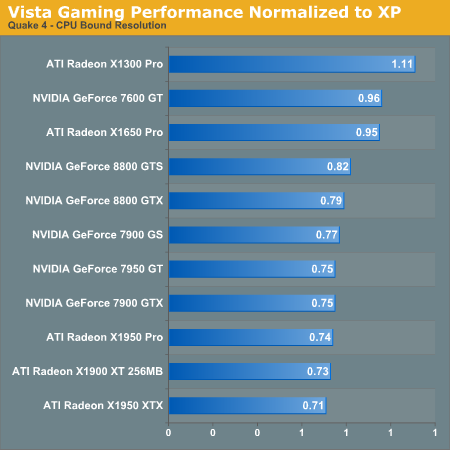
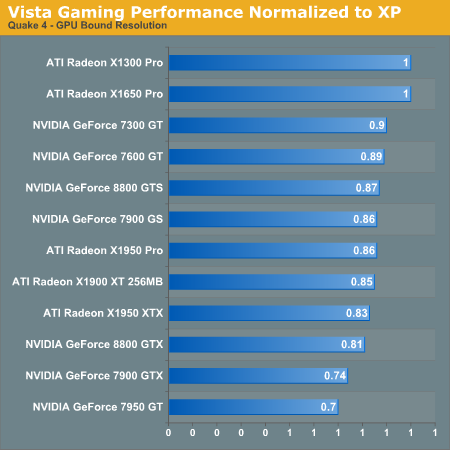
As expected, OpenGL performance is much worse both in CPU limited and GPU limited cases. The reason the low end AMD cards look better off here is that their performance is simply bad across the board. NVIDIA seems to perform closer to XP in general here, and both companies are saying that performance will improve over time. GPU limited performance does seem to improve over CPU limited performance, indicating that driver overhead on the CPU is a major factor contributing to the reduced frame rates.
Now let's take a look at how Vista x64 compares. This will actually serve as a good test of how well NVIDIA and AMD have implemented their x86 and x64 versions of their OpenGL ICD as well.

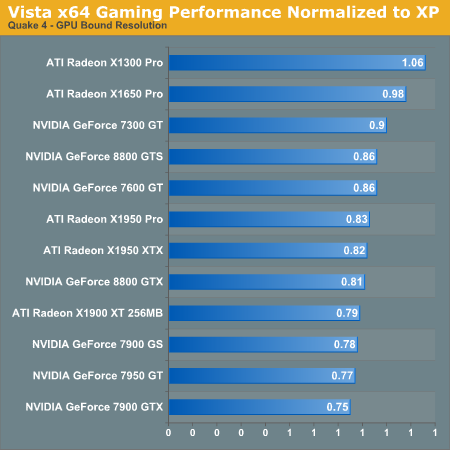
Again, the low end AMD cards just look like they are doing better because they perform poorly in general. In CPU limited cases, x64 actually seems to perform better than under 32-bit Vista, and even GPU limited performance is very close between the Vista versions. This could indicate that AMD and NVIDIA's OpenGL ICDs benefit from 64-bit processing, even if the game itself does not. However, unlike Oblivion, the performance of Quake 4 in Windows Vista is substantially slower than under XP, sometimes as much as 30% slower.
Last up for Quake 4 is resolution scaling.
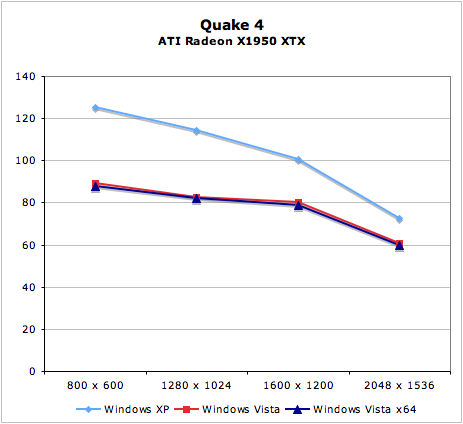
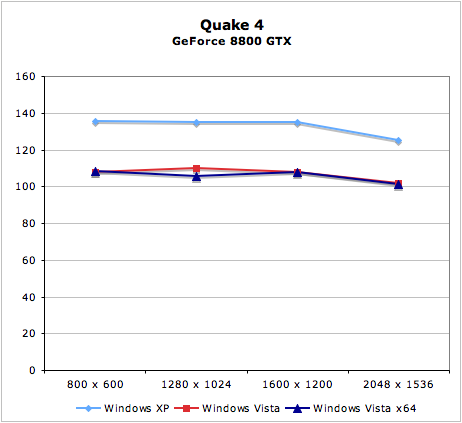
While it's very clear that XP is a better option for OpenGL apps right now, there are no real scaling surprises. The CPU performance/driver overhead seems to be a bigger factor in reduced Vista scores than the actual GPUs, as the scores tend to get closer in GPU limited situations.
Gaming Performance - x64
Finally, we have Half-Life 2: Lost Coast with its native 64-bit application running under Vista x64. Is it worth it? We're only providing resolution scaling results for this game.
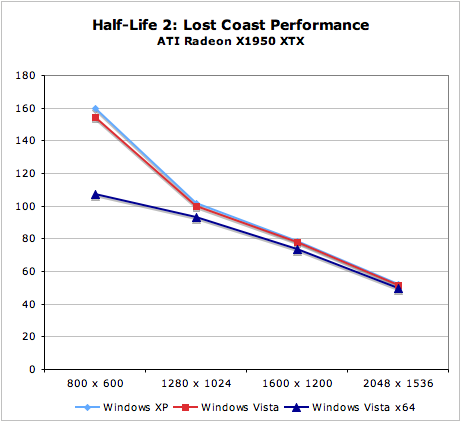
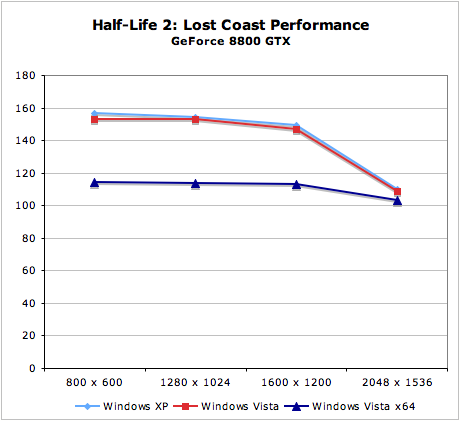
Clearly the 64-bit application runs slower than the 32-bit, especially at CPU limited resolutions. Even the games we tested running under WoW in 32-bit mode on Vista x64 showed better performance parity with Vista x86 and Windows XP. While the resources are there to offer better performance with more registers and better memory management (especially on systems with more than 4GB of RAM), there is clearly something that's lacking here. It is likely that Valve has more work to do on their 64-bit Source engine, but we can't rule out Vista x64 as a factor altogether.
We had hoped to see better performance from a native 64-bit game, but it looks like we'll have to wait longer until game developers figure out how to capitalize on the extra resources available under Vista x64 without adversely affecting performance.
Moving on to OpenGL and Quake 4, we'll be able to see how well NVIDIA and AMD have done in building their own OpenGL ICD (installable client driver) for the API. This is more taxing on hardware vendors, because Microsoft's implementation of OpenGL is just a wrapper around DirectX. By default, unless an ICD is used, OpenGL applications cannot talk directly to the hardware.
We did have some issues with Quake 4 as well. We were unable to get the application to run stable with multi-core support enabled, so we tested without this option. Even on Windows XP we see much higher numbers during CPU limited testing with this option enabled, but we will have to do without for a while. It isn't clear whether this is a problem with the game, with Vista, or with OpenGL, but hopefully it will be resolved (preferably sooner rather than later).


As expected, OpenGL performance is much worse both in CPU limited and GPU limited cases. The reason the low end AMD cards look better off here is that their performance is simply bad across the board. NVIDIA seems to perform closer to XP in general here, and both companies are saying that performance will improve over time. GPU limited performance does seem to improve over CPU limited performance, indicating that driver overhead on the CPU is a major factor contributing to the reduced frame rates.
Now let's take a look at how Vista x64 compares. This will actually serve as a good test of how well NVIDIA and AMD have implemented their x86 and x64 versions of their OpenGL ICD as well.


Again, the low end AMD cards just look like they are doing better because they perform poorly in general. In CPU limited cases, x64 actually seems to perform better than under 32-bit Vista, and even GPU limited performance is very close between the Vista versions. This could indicate that AMD and NVIDIA's OpenGL ICDs benefit from 64-bit processing, even if the game itself does not. However, unlike Oblivion, the performance of Quake 4 in Windows Vista is substantially slower than under XP, sometimes as much as 30% slower.
Last up for Quake 4 is resolution scaling.


While it's very clear that XP is a better option for OpenGL apps right now, there are no real scaling surprises. The CPU performance/driver overhead seems to be a bigger factor in reduced Vista scores than the actual GPUs, as the scores tend to get closer in GPU limited situations.
Gaming Performance - x64
Finally, we have Half-Life 2: Lost Coast with its native 64-bit application running under Vista x64. Is it worth it? We're only providing resolution scaling results for this game.


Clearly the 64-bit application runs slower than the 32-bit, especially at CPU limited resolutions. Even the games we tested running under WoW in 32-bit mode on Vista x64 showed better performance parity with Vista x86 and Windows XP. While the resources are there to offer better performance with more registers and better memory management (especially on systems with more than 4GB of RAM), there is clearly something that's lacking here. It is likely that Valve has more work to do on their 64-bit Source engine, but we can't rule out Vista x64 as a factor altogether.
We had hoped to see better performance from a native 64-bit game, but it looks like we'll have to wait longer until game developers figure out how to capitalize on the extra resources available under Vista x64 without adversely affecting performance.










105 Comments
View All Comments
thebrown13 - Thursday, February 1, 2007 - link
This is TOTALLY false. Microsoft allows content providers to do what they want with their content. Again, THE CONTENT PROVIDERS DECIDE WHAT THEIR CONTENT PLAYS ON. MICROSOFT DECIDES NOTHING.MAIA - Thursday, February 1, 2007 - link
The architecture is still x86 with 64-bit extensions. The correct naming should be 32-bit x86 and 64-bit x86. Although some vendors use the x64 "slang", this only serves to create more confusion, making people believe it's a different architecture. More, editors and reviewers should use the correct definitions, they also have an educating factor which have to live up by a good standart.Ryan Smith - Thursday, February 1, 2007 - link
It makes little sense on our part to use something different than Microsoft's own terminology here when talking about Vista. The x86-64/EMT64/AMD64 versions of Vista are all called Vista * x64, so we're going to be consistent on using Microsoft's naming to avoid possible confusion among Windows versions.Myrandex - Thursday, February 1, 2007 - link
Eh I don't know how x64 can get confusing, but x86_64 is pretty typical as well.smitty3268 - Thursday, February 1, 2007 - link
Actually, it is a new architecture that just happens to be backwards compatible with x86. That is why there are twice the number or registers available and not just the same amount doubled in size. You're right that x64 is not the correct name, (it's technically called x86-64) but what does it matter? Everyone knows what it means.Gunlance - Thursday, February 1, 2007 - link
I wish I could agree about the new installer. My experience with trying to boot windows vista so far is worse than when I learned how to put NetBSD on an Apple G3.In fact I am still trying to get into the Windows Vista setup as I type this comment. I have been up all night :( I simply just don't get it. Every OS I have ever put on my desktop at least boots, and the vista beta's installed fine. Ugh.
The article was great! Heh. It has made me a bit more frustrated though. Because here I am with vista but still only being able to read about.
erwos - Thursday, February 1, 2007 - link
Your OpenGL performance numbers are radically higher than what Tom's has. Could you comment on the drivers and installation that you used?Ryan Smith - Thursday, February 1, 2007 - link
Normally I tend to avoid commenting on anything involving competitors, but...Assuming I'm looking at the right article here, they were using the Catalyst 8.31.100.3.2.1 driver, which was released back in December. We were using the Catalyst 7.1 driver(version # 8.33.something). ATI did not include an OpenGL driver until 7.1(and just barely at that).
ktgktg - Thursday, February 1, 2007 - link
I'm surprised that the article didn't mention how much ReadyBoost could lower the boot time. A member of notebooreview forums claimed that http://forum.notebookreview.com/showthread.php?t=1...">he lowered the boot time on a laptop (slower HD) from 80 to 43 seconds (including POST) with a 2 GB SD card. Remember that http://en.wikipedia.org/wiki/Comparison_of_memory_...">SD cards are slow compared to USB and CF. Although they're all slow compared to RAM, they have the benefit of storing the data until next boot.SuperFetch seems to be just another reason for using standby mode.
yacoub - Thursday, February 1, 2007 - link
Any word on FireFox compatibility with Vista? That is, does it run just as flawlessly as it does under XP x86 and x64?Just wondering. The comment on the Conclusions page about IE 7+ being the new standard for Safari is what made me think to ask.